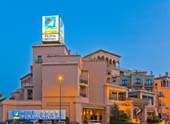A town and parish situated between Exeter and Barnstaple in Devon, Crediton has a population of around 7,000 and a history which stretches back to the times of the Saxons, when St Boniface is reported to have been born there in the 7th century AD. Over the ages a mostly agricultural town Crediton was important for the production of wool between the 13th and 17th centuries. Much of the original medieval town was destroyed by a great fire in 1743. Twentieth century Crediton was mostly involved in tanning, tin-plating and shoe making, it has also been significant for cider production and for confectionery. Crediton enjoys a typical Devon climate with the best weather being during the months of June to September, winters are usually mild in comparison with much of the UK.
September 2, 2010
Teignmouth Devon
A popular town and seaside resort located in the county of Devon, England, Teignmouth stands on the River Teign estuary to the north of Torquay. With a population of around 14,000, Teignmouth is just a small town, though its numbers of course grow during the summer season as thousands of holidaymakers descend on the resort for their summer vacation. For many centuries just a small fishing village, Teignmouth became popular as a holiday destination during Victorian times, after the arrival of the railway line connecting it with neighbouring towns as well as London and Penzance. The fine weather experienced by the town was of course the major draw, but bathing in the healthy sea waters was much the rage during the Victorian era. Historically Teignmouth is famous as being the last place in England to be invaded by a foreign power (1690). The port of Teignmouth has had significance since the 13th century, and handled grain, timber and clay, the first quay was built during the 18th century. These days tourism is the major industry for the town and it has plenty of hotels and guest houses for those wishing to visit the town.
August 30, 2010
Hotel Playacanela Isla Canela
For your accommodation in the Costa de la Luz resort of Isla Canela, you cannot go far wrong by choosing the Playacanela Hotel, a popular 4 Star Hotel located near to the beach and golf course. One of the best loved Isla Canela hotels, the Playacanela has 306 double rooms, all with balcony, bathroom, TV, air-conditioning, safe, min-bar and telephone. Built in an Arabian architectural style the Playacanela Hotel has a beautiful themed pool area, with swimming pool, whirlpool and water slides, all set amongst palm trees and shrubs, making this the ideal spot for a relaxing holiday. As yet mostly undiscovered by Brits and north Europeans, the Costa de la Luz (Coast of Light) is a mostly unspoilt region, with some tranquil, uncrowded resorts, Isla Canela is a built for tourism resort which basically serves the border town of Ayamonte, which sits beside the River Guadiana on the border with Portugal. Rooms in the Playacanela Hotel are offered from around 148 euros per night, but this is luxury accommodation, so heh, why not enjoy it. Costa de la Luz Map.
August 28, 2010
Guadalajara Spain
A city, municipality and province, located to the north-east of Madrid, Guadalajara was once greater than its illustrious neighbour, which is of course now capital of Spain. Many centuries of conflict and wars brought Guadalajara to its knees, and rendered it a mere shadow of its former self. Sitting beside the River Henares, present day Guadalajara has a population of 75,493 inhabitants, with its history, which stretches back to the times of the Romans, lost in its modern day look, though some gems can still be found by its visitors. Once a favourite base of the Mendoza family, Guadalajara still boasts the former palace of this rich family (now restored), in the form of the Palacio de los Duques del Infantado, well worth a visit if you are in the area.
August 20, 2010
Valdepenas Castilla-La Mancha
Located in the Ciudad Real province in the autonomous community of Castilla-La Mancha, the city of Valdepenas is best known for its wine industry which has taken place since the times of the ancient Iberians. Its 47 vineyards produce some 50 million litres of wine each year, both for local consumption and for export. Valdepenas itself has little to commend it being a mostly modern city though you might want to visit the Iglesia de la Asunción if you are especially interested in churches. A good reason to visit is however to visit the local Bodegas (especially on the road to Madrid) to taste some of the famous wines and also learn a little of how the wines are produced, if you are a wine fanatic then you should visit during September when the wine festival is in full swing. One of the larger cities of the Castilla-La Mancha region, Valdepenas has a population of around 32,000 and a municipal area of 487 square kilometres. Nearby towns and villages include Moral de Calatrava, Santa Cruz de Mudela, Villanueva de los Infantes and Manzanares. Castilla-La Mancha Map.
August 9, 2010
Siguenza Castilla-La Mancha
A small town located about 120 kilometres east of Madrid, Siguenza is dominated by its ancient castle, now a parador (hotel) which was restored in the 1970’s after being severely damaged during the Spanish Civil War. The town itself has a population of around 5,000, and among its many attractions are its cathedral, begun in the 12th century and built from the pinkish stone typical of the town’s buildings. Those interested in religious art can head for the Museo Diocesano del Arte. If you wish to stay overnight in Siguenza, you should consider the Parador de Siguenza Hotel, housed in the Moorish castle, overlooking the town, here you can soak in the history of this fascinating place.

